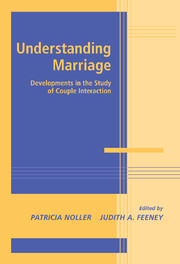Book contents
- Frontmatter
- Contents
- Contribitors
- Introduction
- SECTION ONE THE EFFECT OF COGNITION ON INTERACTION PATTERNS
- SECTION TWO UNDERSTANDING THE IMPORTANCE OF POSITIVE INTERACTION
- SECTION THREE COPING WITH DISAPPOINTMENT, CRITICISM, AND BETRAYAL
- SECTION FOUR POWER, CONFLICT, AND VIOLENCE IN MARITAL INTERACTION
- Marital interaction at important transition periods
- Introduction to Section Five
- 14 Adult Attachment, the Transition to Parenthood, and Marital Well-Being
- 15 Allocation and Performance of Household Tasks: A Comparison of New Parents and Childless Couples
- 16 Care Giving and Its Influence on Marital Interactions between Older Spouses
- SECTION SIX Interventions for strengthening relationships
- Conclusions
- Index
Introduction to Section Five
Published online by Cambridge University Press: 25 July 2009
- Frontmatter
- Contents
- Contribitors
- Introduction
- SECTION ONE THE EFFECT OF COGNITION ON INTERACTION PATTERNS
- SECTION TWO UNDERSTANDING THE IMPORTANCE OF POSITIVE INTERACTION
- SECTION THREE COPING WITH DISAPPOINTMENT, CRITICISM, AND BETRAYAL
- SECTION FOUR POWER, CONFLICT, AND VIOLENCE IN MARITAL INTERACTION
- Marital interaction at important transition periods
- Introduction to Section Five
- 14 Adult Attachment, the Transition to Parenthood, and Marital Well-Being
- 15 Allocation and Performance of Household Tasks: A Comparison of New Parents and Childless Couples
- 16 Care Giving and Its Influence on Marital Interactions between Older Spouses
- SECTION SIX Interventions for strengthening relationships
- Conclusions
- Index
Summary
As conceptualized in this section, transitions are points where partners' roles within the marital relationship change markedly. These transition points are interesting to study because forces internal and external to the relationship can create major changes in relationship roles and shape new interaction patterns. These changes require partners to actively renegotiate aspects of their marriage, and these processes are likely to be critical for the future success of the relationship.
The chapters in this section are concerned with marital interaction following two major transitions: the transition to parenthood and the transition from a relatively equal partnership to one where one partner becomes the caregiver of the other. The chapters explore such key issues as the nature of couple communication, expectations and perceptions of the partner, and changes in individual and couple well-being.
Simpson and his colleagues explore attachment-related issues in the transition to parenthood. First-time parenthood is likely to make attachment issues highly salient, as the marital relationship needs to accommodate a new and highly dependent family member. The demands of caring for a newborn infant can make it difficult for partners to give each other the attention they have been used to, and fulfilling these demands may interfere with opportunities for couple intimacy. Ambivalently attached women, who are highly anxious about their relationship, are likely to find these changes very difficult to cope with, particularly if they see their spouse as unavailable or unsupportive.
Information
- Type
- Chapter
- Information
- Understanding MarriageDevelopments in the Study of Couple Interaction, pp. 381 - 384Publisher: Cambridge University PressPrint publication year: 2002
